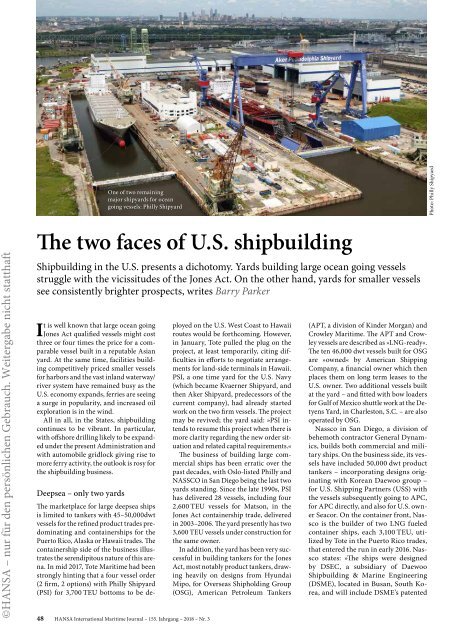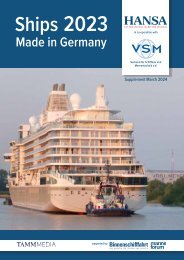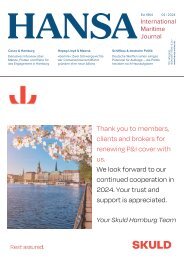Erfolgreiche ePaper selbst erstellen
Machen Sie aus Ihren PDF Publikationen ein blätterbares Flipbook mit unserer einzigartigen Google optimierten e-Paper Software.
Schiffstechnik | Ship Technology<br />
One of two remaining<br />
major shipyards for ocean<br />
going vessels: Philly Shipyard<br />
Photo: Philly Shipyard<br />
The two faces of U.S. shipbuilding<br />
Shipbuilding in the U.S. presents a dichotomy. Yards building large ocean going vessels<br />
struggle with the vicissitudes of the Jones Act. On the other hand, yards for smaller vessels<br />
see consistently brighter prospects, writes Barry Parker<br />
It is well known that large ocean going<br />
Jones Act qualified vessels might cost<br />
three or four times the price for a comparable<br />
vessel built in a reputable Asian<br />
yard. At the same time, facilities building<br />
competitively priced smaller vessels<br />
for harbors and the vast inland waterway/<br />
river system have remained busy as the<br />
U.S. economy expands, ferries are seeing<br />
a surge in popularity, and increased oil<br />
exploration is in the wind.<br />
All in all, in the States, shipbuilding<br />
continues to be vibrant. In particular,<br />
with offshore drilling likely to be expanded<br />
under the present Administration and<br />
with automobile gridlock giving rise to<br />
more ferry activity, the outlook is rosy for<br />
the shipbuilding business.<br />
Deepsea – only two yards<br />
The marketplace for large deepsea ships<br />
is limited to tankers with 45–50,000dwt<br />
vessels for the refined product trades predominating<br />
and containerships for the<br />
Puerto Rico, Alaska or Hawaii trades. The<br />
containership side of the business illustrates<br />
the serendipitous nature of this arena.<br />
In mid 2017, Tote Maritime had been<br />
strongly hinting that a four vessel order<br />
(2 firm, 2 options) with Philly Shipyard<br />
(PSI) for 3,700 TEU bottoms to be deployed<br />
on the U.S. West Coast to Hawaii<br />
routes would be forthcoming. However,<br />
in January, Tote pulled the plug on the<br />
project, at least temporarily, citing difficulties<br />
in efforts to negotiate arrangements<br />
for land-side terminals in Hawaii.<br />
PSI, a one time yard for the U.S. Navy<br />
(which became Kvaerner Shipyard, and<br />
then Aker Shipyard, predecessors of the<br />
current company), had already started<br />
work on the two firm vessels. The project<br />
may be revived; the yard said: »PSI intends<br />
to resume this project when there is<br />
more clarity regarding the new order situation<br />
and related capital requirements.«<br />
The business of building large commercial<br />
ships has been erratic over the<br />
past decades, with Oslo-listed Philly and<br />
NASSCO in San Diego being the last two<br />
yards standing. Since the late 1990s, PSI<br />
has delivered 28 vessels, including four<br />
2,600 TEU vessels for Matson, in the<br />
Jones Act containership trade, delivered<br />
in 2003–2006. The yard presently has two<br />
3,600 TEU vessels under construction for<br />
the same owner.<br />
In addition, the yard has been very successful<br />
in building tankers for the Jones<br />
Act, most notably product tankers, drawing<br />
heavily on designs from Hyundai<br />
Mipo, for Overseas Shipholding Group<br />
(OSG), American Petroleum Tankers<br />
(APT, a division of Kinder Morgan) and<br />
Crowley Maritime. The APT and Crowley<br />
vessels are described as »LNG-ready«.<br />
The ten 46,000 dwt vessels built for OSG<br />
are »owned« by American Shipping<br />
Company, a financial owner which then<br />
places them on long term leases to the<br />
U.S. owner. Two additional vessels built<br />
at the yard – and fitted with bow loaders<br />
for Gulf of Mexico shuttle work at the Detyens<br />
Yard, in Charleston, S.C. – are also<br />
operated by OSG.<br />
Nassco in San Diego, a division of<br />
behemoth contractor General Dynamics,<br />
builds both commercial and military<br />
ships. On the business side, its vessels<br />
have included 50,000 dwt product<br />
tankers – incorporating designs originating<br />
with Korean Daewoo group –<br />
for U.S. Shipping Partners (USS) with<br />
the vessels subsequently going to APC,<br />
for APC directly, and also for U.S. owner<br />
Seacor. On the container front, Nassco<br />
is the builder of two LNG fueled<br />
container ships, each 3,100 TEU, utilized<br />
by Tote in the Puerto Rico trades,<br />
that entered the run in early 2016. Nassco<br />
states: »The ships were designed<br />
by DSEC, a subsidiary of Daewoo<br />
Shipbuilding & Marine Engineering<br />
(DSME), located in Busan, South Korea,<br />
and will include DSME’s patented<br />
48 HANSA International Maritime Journal – 155. Jahrgang – 2018 – Nr. 3


















